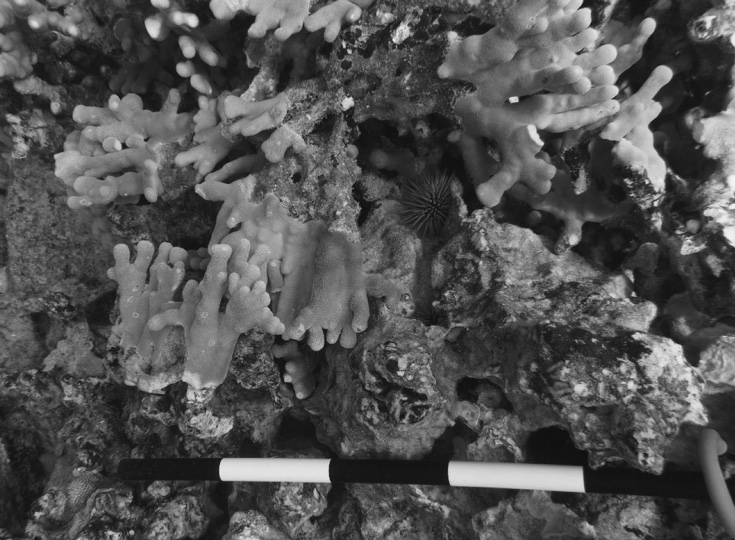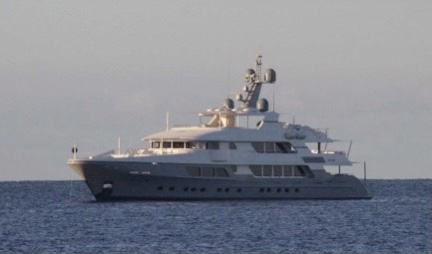Case No. 1: On May 28, 2021, based on two anonymous tips about a vessel’s chain dragging along the sea floor and damaging coral, staff from three divisions within the state Department of Land and Natural Resources boarded a 54-foot red yacht owned by John Joseph Barry III of Colorado.
The vessel, Avalanche, was anchored within the boundaries of the Kaloko-Honokohau National Historic Park along the Kona coast of Hawai‘i island. During the boarding, a survey of the underlying reef by a Division of Aquatic Resources biologist found that the anchor rested in a sand patch, but the connecting chain lay over 28 meters of coral reef and live rock and had caused extensive damage along its path.

A follow-up SCUBA survey by DAR biologists four days later found that 101 coral colonies and 58 pieces of live rock had been damaged.
More than a year later, on December 8, 2022, DAR recommended that the Land Board fine Barry and Avalanche Adventures Corp. $43,417.20 for the damages and DAR’s costs of investigating the incident.
In written testimony submitted to board members and DAR administrator Brian Neilson on December 6, Barry noted his family’s lifetime dream of sailing around the world in their own boat and that he and his wife “departed with an agenda of environmental work mostly concerning the buildup of plastic materials in the oceans and humanitarian work with children. My whole family finds Hawai‘i’s charges against us to be extremely upsetting and ironic to our collective world mission!”
He apologized for any damage his boat may have caused to the reef but challenged some of the DAR report’s findings. The report noted that before DLNR staff boarded the Avalanche, Ryan Ta of Big Island Divers had informed a Division of Conservation and Resources Enforcement officer that he had noticed what was occurring with the vessel’s chain while diving with a tour group. Ta said he “attempted to alert a male member of the crew of the Avalanche that their anchor was not set correctly, but the male crew member dismissed him, believing the anchor to be in sand,” DAR’s report to the board states.
Barry denied that this ever happened and called that part of the report “an embellishment!”
He continued that the DOCARE officer, Destiny Ho‘opi‘i, had “decided to not write up a violation because she didn’t think that we had any intention to damage the reef, there really wasn’t much damage. … She said that she would recommend to her superior to do nothing concerning this event.”
He said that when he dove the area later, he noticed that all of the sandy areas had recent damage to surrounding coral. Noting that many boats had anchored there before the Avalanche, he questioned whether anyone could know that the damage reported by DAR was his or his vessel’s fault. “I don’t think anyone could truthfully say that the coral condition was due to our brief stay,” he wrote.
He asked that Neilson and the Land Board dismiss the enforcement action against him.
Neither Barry nor any representatives of him or his company attended the December 9 Land Board meeting, which was open to both in-person testifiers and Zoom participants.
DAR’s David Sakoda told the board that he had called Barry and sent letters about the enforcement action. “He was pretty uncooperative. I asked for his email. He hung up on me,” he said. Later, he added, Barry emailed DAR his version of the incident.
Days before the Land Board meeting, Sakoda said he sent Barry the agenda and a Zoom link with an invitation to attend. Dan Morris, the deputy attorney general advising the board, said that he believed DAR had provided Barry with sufficient notice.
Board member Kaiwi Yoon asked DAR staff about Barry’s assertion that Ho‘opi‘i told him she didn’t think the damage warranted a citation.
Chris Teague, the DAR biologist who had boarded the vessel and documented the damage with video that day, replied, “I have a really hard time believing the DOCARE officer said that.”
Sakoda clarified that a criminal citation that DOCARE might issue differs from an administrative action initiated by DAR. Both actions can run parallel, he said.
Board members expressed concern over what the state’s recourse would be if Barry chose not to pay the fine by the 60-day deadline, since neither he nor the vessel are located in Hawai‘i. Sakoda said DAR could pursue a judgment in Circuit Court.
Board members Riley Smith and Aimee Barnes lamented Barry’s apparent lack of concern about the whole thing. Smith also thought that the proposed fine should have included DOCARE’s costs.
“I find his email to be disingenuous and not convincing,” Barnes said. “If this trip was really around their mission to take a ‘round-the-world sailing trip with an agenda of environmental work, as an environmentalist I can tell you that even if I didn’t think I caused damage to the reef, I would most certainly pay fines associated with putting it back in the right place. … I also think that somebody who has time and resources to sail around the world certainly has time and resources to show up to our meeting, answer our questions and pay our fine.”
The board unanimously approved the recommended fines. Yoon asked for a status check after the 60-day deadline passed, which would most likely happen at the Land Board’s first meeting in February.
Case No. 2: In the Avalanche case, members of the public and state biologists had taken photos and video of the reef damage caused by the vessel’s anchor chain as it was still moored.
DAR’s case against Kimberly Brady, owner of the charter catamaran Blaze II, for damages to live rock outside West Maui’s Mala Wharf was not so clear-cut. It originated with testimony and evidence provided by a member of the public who Brady and her associates claim is a “bad actor.” They went so far as to suggest that he may have placed the catamaran’s anchor and chain on the reef.
DAR’s report stated that Brent Hartwig, owner of Pono Marine Mooring, observed the vessel moored overnight and suspected it may have been anchored on coral. He swam out to the vessel early on March 25 to inspect the coral beneath it and saw “numerous damaged coral colonies in close proximity to Blaze II’s anchor and anchor chain,” which he documented with photos, video, and GPS coordinates. (The video, which he posted on YouTube, follows an anchor, hooked on coral, and its chain up to the catamaran. At one point, however, it appears the video was edited along the way.)
He notified DOCARE and DAR, but DAR staff did not conduct their own survey until April 7. Using the GPS coordinates Hartwig provided, DAR divers were able to survey the anchor chain’s 13.5-square-meter impact scar.
DAR found that 38 specimens of stony coral and surrounding live rock had been damaged and concluded that the Blaze II had caused it when it was anchored outside the wharf March 24-25, 2021. The division recommended a fine of $30,950.
At the Land Board’s December 9 meeting, Brady insisted she had placed her anchor on sand, not coral. She added that she had moored there only because she had run into a storm while returning from O‘ahu. A text Brady sent to Hartwig in late March 2021, which was included in DAR’s report, suggests that she believed she had placed her anchor properly, but the wind had dragged it.
Brady also raised the possibility that the anchor in the video is not hers.
In response to questioning by Land Board members, DAR’s David Sakoda conceded that Brady and those who testified in her support were correct in that DAR’s investigation was based on information provided by Hartwig.
Land Board member Riley Smith questioned Hartwig’s behavior. “Diving under someone’s boat at 6:30 in the morning, I would never do that,” he said.
Board member Doreen Canto said she didn’t want to cast any judgment on Hartwig but made a motion to deny DAR’s recommendation given the questions raised by members of the public. Her motion passed, with members Smith, Vernon Char, and Karen Ono also voting in favor.
Before the vote, Smith said that if the background information was a little tighter, if DAR could confirm the anchor was the same kind Brady uses, he could support DAR’s recommendations.
Chair Case and member Aimee Barnes voted in opposition. Board member Kaiwi Yoon abstained.
Case No. 3: On December 9, the Land Board accepted a contested case hearing request by Capt. Anthony Hodgson of Fort Lauderdale, Florida, and 2G Vessel Owner Limited of George Town in the Cayman Islands.
DAR alleged that the anchor and chain of 2G’s 164-foot luxury charter yacht, Endless Summer, had damaged approximately 578 specimens of stony coral and two specimens of live rock as it was anchored in the Kailua Bay Fisheries Management Area, off the Kona coast, on September 29, 2021. The division proposed a fine of $261,281.37.
Following a report from Atlantis Adventures about extensive coral damage beneath the Endless Summer, DAR, DOCARE, and Division of Boating and Ocean Recreation staff visited the vessel, which was still onsite, on September 30. DAR divers observed the chain scraping and demolishing coral colonies, according to a staff report.
DAR conducted a fuller assessment on October 1, 2021.
In a December 6 letter to the Land Board, attorney Lisa Bail, on behalf of Hodgson and 2G, asked the board to eliminate all penalties against the captain and eliminate or cut in half the penalty against 2G.
She argued that DAR could have mitigated the damage by “promptly radioing the Endless Summer as soon as it discovered that harm was occurring, but it failed to act.” She stated that DAR contacted the Endless Summer about the coral damage 17 hours after first hearing reports of it.
She also described the care Hodgson took to make sure he anchored properly. Again, she placed some blame on DLNR, stating that it did not answer when Hodgson reached out to get appropriate anchoring locations.
At the Land Board’s meeting, before any of this could be discussed, Bail asked for a contested case hearing.
— Teresa Dawson


Leave a Reply